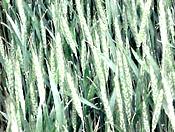
Carbon
Dioxide: Plants
As described in the
"Carbon Dioxide: Overview" section
of this module, plants use carbon dioxide (CO2) during photosynthesis--the
process by which plants transform the sun's energy into a chemical form
and create carbohydrate (C6H12O6) molecules. Plants use this
chemical to
grow.
If the concentration of atmospheric CO2 available to plants increases, plants may be able to increase their rate of photosynthesis and thus grow more. This response of plants to elevated concentrations of CO2 is known as the "carbon dioxide fertilization effect." Scientists have observed this effect during experimentation; they have seen as much as a 35% increase in the yield of plants like wheat in response to a doubling of atmospheric CO2 from 350 ppm to 700 ppm. Such observations have led many people to believe that the increase in atmospheric CO2 that has been occurring since the Industrial Revolution may contribute to increased crop yield.
 Increased
concentrations of atmospheric CO2 also result in increased water-use
efficiency by causing plants to partially close their stomates--the
small openings in their leaves through which they absorb CO2 and release
water vapor. With their stomates--the small openings in their leaves
through which they absorb CO2 and release water vapor. With their stomates
partially closed, plants may lose less water during transpiration. This can have a positive affect on
plant growth and, ultimately, crop yield. Photo:
Winter wheat in Kansas in May 1999. Photo courtesy of Wheat Mania.com.
Increased
concentrations of atmospheric CO2 also result in increased water-use
efficiency by causing plants to partially close their stomates--the
small openings in their leaves through which they absorb CO2 and release
water vapor. With their stomates--the small openings in their leaves
through which they absorb CO2 and release water vapor. With their stomates
partially closed, plants may lose less water during transpiration. This can have a positive affect on
plant growth and, ultimately, crop yield. Photo:
Winter wheat in Kansas in May 1999. Photo courtesy of Wheat Mania.com.
However, during many of the above-mentioned CO2 experiments, all other factors affecting plant growth--for example, temperature, water, nutrients, etc.--were optimum. This is seldom the case in nature. In fact, elevated concentrations of atmospheric CO2 may actually cause changes in temperature and precipitation patterns. Such changes can cause a decrease in crop yield and thus dampen the beneficial affects of increased CO2 on crop yield.
In addition, elevated concentrations of CO2 in the atmosphere may lead to elevated concentrations of carbon in plants' leaves relative to the amount of nutrients such as nitrogen and phosphorus. Consequently, insects may have to eat more of the carbon-rich leaves in order to obtain enough essential nutrients. The resulting increase in herbivory may lead to a decrease in crop yield.
Overview
..|..
Temperature ..|..
Precipitation
..|..
Plants
Glossary ..|..
Related
Links ..|..
References
|..
PBL
Model
Home ..|.. Teacher Pages ..|.. Modules & Activities
HTML code by Chris
Kreger
Maintained by ETE
Team
Last updated November 10, 2004
Some images © 2004 www.clipart.com
Privacy Statement and Copyright © 1997-2004 by Wheeling Jesuit University/NASA-supported Classroom of the Future. All rights reserved.
Center for Educational Technologies, Circuit Board/Apple graphic logo, and COTF Classroom of the Future logo are registered trademarks of Wheeling Jesuit University.
